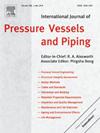Study on the evolution mechanism and influencing factors of CO2 corrosion product film under pipe flow
IF 3
2区 工程技术
Q2 ENGINEERING, MECHANICAL
International Journal of Pressure Vessels and Piping
Pub Date : 2025-03-14
DOI:10.1016/j.ijpvp.2025.105506
引用次数: 0
Abstract
CO2 corrosion constitutes a common form of corrosion in oil and gas pipelines. The presence of elevated concentrations of CO2 in produced water from oil and gas fields has the potential to cause significant corrosion of pipelines and associated equipment, resulting in substantial economic losses. This paper presents the findings of an experimental study of CO2 corrosion at different flow rates and times. It analyses the mechanism by which CO2 corrosion products evolve over time at various flow rates, utilizing a combination of characterization techniques, including electrochemical testing, scanning electron microscopy (SEM), energy-dispersive spectroscopy (EDS) and X-ray diffraction (XRD). The experimental setup is an independently designed gas-liquid two-phase flow loop system. The results demonstrate that the flow rate exerts a significant influence on the integrity of the corrosion products. As the flow rate increases, the corrosion rate of the 20# steel initially rises before subsequently declining. The formation and evolution of CO2 corrosion products under static conditions can be divided into four main stages: the diffusion of the corrosive medium, substrate dissolution, the formation of the product film and continued corrosion. Nevertheless, the flow rate exerts an influence on the formation and integrity of the corrosion product film. At 0.75 m/s, the corrosion behavior is characterized by accelerated corrosion. At 1.2 m/s, the corrosion behavior is characterized by alternating cycles of accelerated corrosion product deposition → erosion damage → accelerated corrosion product deposition → erosion damage.
管道流动下CO2腐蚀产物膜的演化机理及影响因素研究
二氧化碳腐蚀是石油和天然气管道中常见的腐蚀形式。油气田采出水中二氧化碳浓度升高,可能会对管道和相关设备造成严重腐蚀,从而造成巨大的经济损失。本文介绍了不同流速和时间下CO2腐蚀的实验研究结果。它利用电化学测试、扫描电子显微镜(SEM)、能谱(EDS)和x射线衍射(XRD)等表征技术,分析了不同流速下CO2腐蚀产物随时间变化的机理。实验装置是独立设计的气液两相流回路系统。结果表明,流速对腐蚀产物的完整性有显著影响。随着流量的增加,20#钢的腐蚀速率先上升后下降。静态条件下CO2腐蚀产物的形成和演化可分为腐蚀介质扩散、基材溶解、产物膜形成和持续腐蚀四个主要阶段。然而,流速对腐蚀产物膜的形成和完整性有影响。在0.75 m/s时,腐蚀行为表现为加速腐蚀。在1.2 m/s时,腐蚀行为表现为加速腐蚀产物沉积→侵蚀损伤→加速腐蚀产物沉积→侵蚀损伤的交替循环。
本文章由计算机程序翻译,如有差异,请以英文原文为准。
求助全文
约1分钟内获得全文
求助全文
来源期刊
CiteScore
5.30
自引率
13.30%
发文量
208
审稿时长
17 months
期刊介绍:
Pressure vessel engineering technology is of importance in many branches of industry. This journal publishes the latest research results and related information on all its associated aspects, with particular emphasis on the structural integrity assessment, maintenance and life extension of pressurised process engineering plants.
The anticipated coverage of the International Journal of Pressure Vessels and Piping ranges from simple mass-produced pressure vessels to large custom-built vessels and tanks. Pressure vessels technology is a developing field, and contributions on the following topics will therefore be welcome:
• Pressure vessel engineering
• Structural integrity assessment
• Design methods
• Codes and standards
• Fabrication and welding
• Materials properties requirements
• Inspection and quality management
• Maintenance and life extension
• Ageing and environmental effects
• Life management
Of particular importance are papers covering aspects of significant practical application which could lead to major improvements in economy, reliability and useful life. While most accepted papers represent the results of original applied research, critical reviews of topical interest by world-leading experts will also appear from time to time.
International Journal of Pressure Vessels and Piping is indispensable reading for engineering professionals involved in the energy, petrochemicals, process plant, transport, aerospace and related industries; for manufacturers of pressure vessels and ancillary equipment; and for academics pursuing research in these areas.

 求助内容:
求助内容: 应助结果提醒方式:
应助结果提醒方式:


